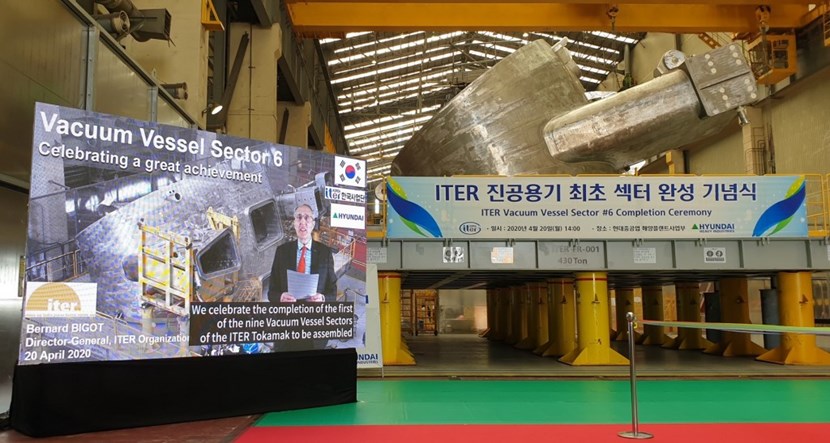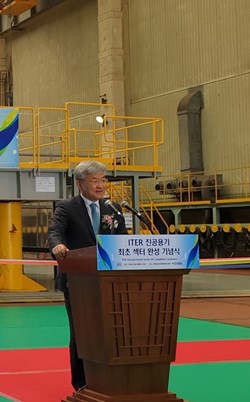ITER NEWSLINE
-
First vacuum vessel sector
A "landmark day" celebrated in Korea
First vacuum vessel sector | A "landmark day" celebrated in Korea
A ceremony was held today, 20 April, in Ulsan, South Korea, to mark the completion of the first ITER vacuum vessel sector. This remarkable piece of tokamak engineering has been more than 10 years in the making.

Due to worldwide travel restrictions, ITER Director-General Bernard Bigot participated in the ceremony 20 April by video conference.
Vacuum vessel sector #6—the first-completed segment of the vacuum vessel construction program—is ready to leave the workshops of Hyundai Heavy Industries in Ulsan, Korea, for shipment to ITER. The 440-tonne, double-walled vessel is nearly 14 metres in height, 6 metres in width and 8 metres in length. Nine sectors in all—four procured by the Korean Domestic Agency and five procured by the European Domestic Agency—will be assembled and welded at ITER.

Gyung Su Lee—former President of the National Fusion Research Institute of Korea, former Head of ITER Korea, and Deputy Director-General and Chief Operating Officer of the ITER Project from October 2015 to this year—knows just how much effort, ingenuity, dedication and skill have gone into the successful manufacturing program for ITER vacuum vessel sector #6.
Due to worldwide travel restrictions, ITER Director-General Bernard Bigot participated in today's ceremony remotely.
"Today is a very special day for ITER Project, a true landmark. Every engineer who has been involved in the design and manufacture of this remarkable piece of tokamak engineering understands the unprecedented nature of this challenge. With exceptionally complex geometries, 1,380 metres of intricate welding, internal in-wall shielding blocks and cooling water channels, hundreds of interfaces to other components, and very strict nuclear safety compliance requirements, it has been difficult—I might say 'painful' and nearly impossible—at times. Each step has been challenging, from manufacturing qualification, machining, and welding, to non-destructive examination and verifying tolerances. Hundreds of people have been involved in the design and manufacture of this challenging first-of-a-kind component. Today, they are all present in our mind."
The ITER Director-General thanked members of the Korean government, Hyundai Heavy Industries, the Korean Domestic Agency, the ITER Vacuum Vessel Project Team, and key ITER staff for the successful accomplishment of this milestone.
The ITER Newsline will have a full technical report on 27 April.
return to the latest published articles








